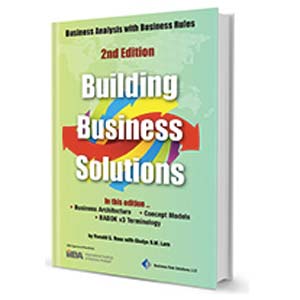The Process Life — What's It All About?
What's it all about?
If you google "what's it all about" you get 4.5 billion results. Seems that we are keen to answer that question. Of course, it would be much more useful if there were just one answer.
I have a similar experience when I ask people what they understand by "business process management" and related phrases. [2.5 billion, in case you were wondering.] It would be of significant benefit if there were just one answer here also.
Good news! There is just one answer. The bad news is we all agree with that but have a different version. The great news is that we can solve this problem — if you all repent and agree with me!
The meaning of (process) life
Let's start with the very big picture. The main game is about creating and sustaining effective and efficient management of our organizations. That means the effective and efficient delivery of the products and services that we promise to provide stakeholders as documented in our statements of strategic intent (vision, mission, values, objectives, etc.) So, producing the right stuff and doing so in a way that keeps everybody happy, including us, is everyone's overall objective.
In every organization, we produce goods and services through collaboration across the organization. Somebody determines there is a need, others do the design, someone builds it, someone else sells it, yet others install and maintain. Both the customer service and the internal organizational benefit requires all of that. This is a cross-functional business process, and it is the only way products and services are delivered — the only way strategy is executed.
So, processes are how we get stuff done, how we execute strategy. Surely it is obvious that we must therefore manage and improve those processes for optimum performance. "Manage" means understanding how they work, knowing how they should perform and are performing, and making evidence-based decisions about problems that should be solved or opportunities that should be realized. "Improve" means then getting on and solving those problems and realizing those opportunities and being able to prove that the benefits were delivered (or not delivered).
From this high level, the idea that we must manage and improve business processes to improve organizational performance is surely uncontestable? I've written about this topic in detail in other places, for example here, there, and everywhere, and won't repeat the detail here.
An important general point to make is that process management and improvement does not equate to technology change — automation, integration, robotics, etc. As important as technology is in the management and execution of processes, if we start with technology, we don't do process-based management; rather. we do technology-based management. Strategy execution through effective and efficient management is the objective; technology is one of the improvement methods.
Our focus must be on organizational outcomes, on the successful execution of organizational strategy. We must look to the success of the organizational system, not just success of the sub-strategies related to critical elements such as finance, people, facilities, or technology.
We need a comprehensive, holistic view of organizational performance. Process-based management gives us that.
A system of perpetual improvement
A recent article in Harvard Business Review[1] highlighted the problem that many organizations have with process improvement, i.e., sustaining process improvements over time. I think the content of the article also highlighted why this happens. The focus of the analysis in the article is on the process improvement project, on what can be done to improve the project, on the need to embed change management in the project, on the leadership and vision required to drive the project. All these things are, of course, important, but if the focus is just on the project, what happens after the project? By definition, a project is not part of business as usual. Ongoing operation of continuously-improving process performance is meant to be part of business as usual. What happens after, and before, the project makes the critical difference.
The process architecture — the set of processes that defines how strategy is to be executed — is the engine that drives performance. It needs to be managed, not as a project or series of projects but as a system of perpetual improve
ment.
Bike — Not Bike
Imagine a bicycle — any color, any size, any type. Now imagine that same bicycle as a disassembled collection of all its parts. Fully assembled or a box of parts, which of those is a bicycle? We might argue they both are, but I know which one I want to ride. I know which one will best deliver on my transportation needs. We need a coherent system that is well maintained and whose performance is understood and consciously optimized.
Gardening — Not Gardening
I have some soil, seeds, water, and tools. Am I gardening? Of course not. A packet of seeds and a shovel is not gardening. Good gardening requires much more than having all the right components. Those components must form a managed system that facilitates establishment of the garden and its ongoing health and development.
Systemic process-based management
When it comes to process management and improvement, failure (or at least a diminished level of success) comes from focusing on just some of the components at the expense of the whole. We have technology solutions for process problems that are not well understood. We have process problems for which we have no hard data about real performance and impact. We invest significant effort into the improvement of processes that should not exist. We can't see the forest for the trees, the process architecture for the problem-du-jour.
Organizations need both continuous process improvement and continuous process management. The components that make such a perpetual improvement engine are these:
- A mechanism to continuously and consciously track, analyze, and act on performance anomalies and opportunities, especially for the organization's high-impact processes.
- Knowledge of the set of processes that execute strategy and the interrelationships between them, at least the critical few if not the important many.
- Knowledge about the expected and real performance of those processes at all times, across the operational cycle of the organization.
- An additional role to have oversight of cross-functional performance, given that the traditional roles defined in the organization charts are not about what happens across the chart.
- Action to deliver positive performance changes by removing causes of problems and constraints on realizing opportunities.
- Deliberate, active plans to build and maintain a process-aware culture.
- Development plans to ensure that the right tools and techniques can be used appropriately by all staff.
- Mechanisms to support the organization, its people, and their teams, through the change to, and ongoing use of, process-based management.
This is the systemic approach that leads to better organizational performance through genuine continuous improvement of processes driven by evidence-based assessment of where the best return on process will be found.
So, what's it all about?
So, what's it all about, this process life?
It's about understanding that the process architecture defines the value pathways of an organization, and we need a comprehensive, holistic view of all aspects of how those processes work and the many ways in which they might be improved.
Management should not be about managing the status quo, interlaced with ad hoc activity to fix those problems that can't be ignored. Management should be about creating a controlled system that continually searches for and makes positive change. This is achieved by managing and improving business processes through the many elements that contribute to their operation — people, facilities, technology, rules, information, applications, policies, and any other element that can impact process performance.
What's the process life all about? It's first and foremost about the reality that the management and improvement of the processes of organizational life is the primary mode of performance improvement. Fortunately, it turns out that this is not hard to achieve.
References
[1] "Making Process Improvements Stick," Harvard Business Review, (November-December 2018), pp. 16-19.
# # #
About our Contributor:
Online Interactive Training Series
In response to a great many requests, Business Rule Solutions now offers at-a-distance learning options. No travel, no backlogs, no hassles. Same great instructors, but with schedules, content and pricing designed to meet the special needs of busy professionals.












How to Define Business Terms in Plain English: A Primer
How to Use DecisionSpeak™ and Question Charts (Q-Charts™)
Decision Tables - A Primer: How to Use TableSpeak™
Tabulation of Lists in RuleSpeak®: A Primer - Using "The Following" Clause
Business Agility Manifesto
Business Rules Manifesto
Business Motivation Model
Decision Vocabulary
[Download]
[Download]
Semantics of Business Vocabulary and Business Rules